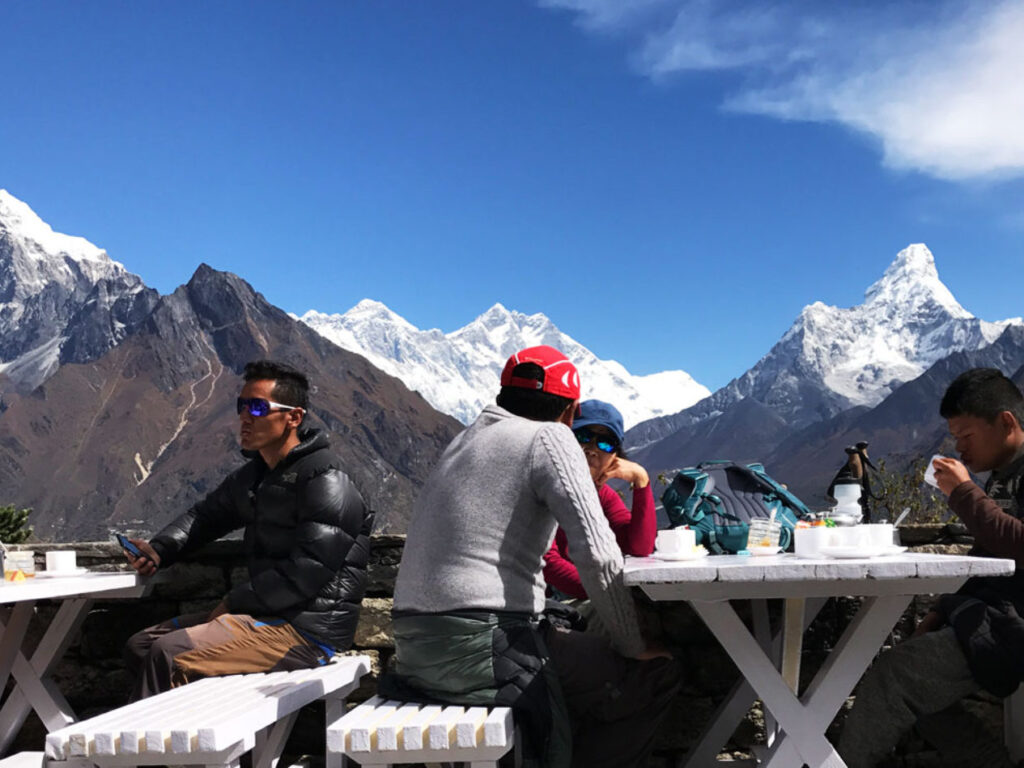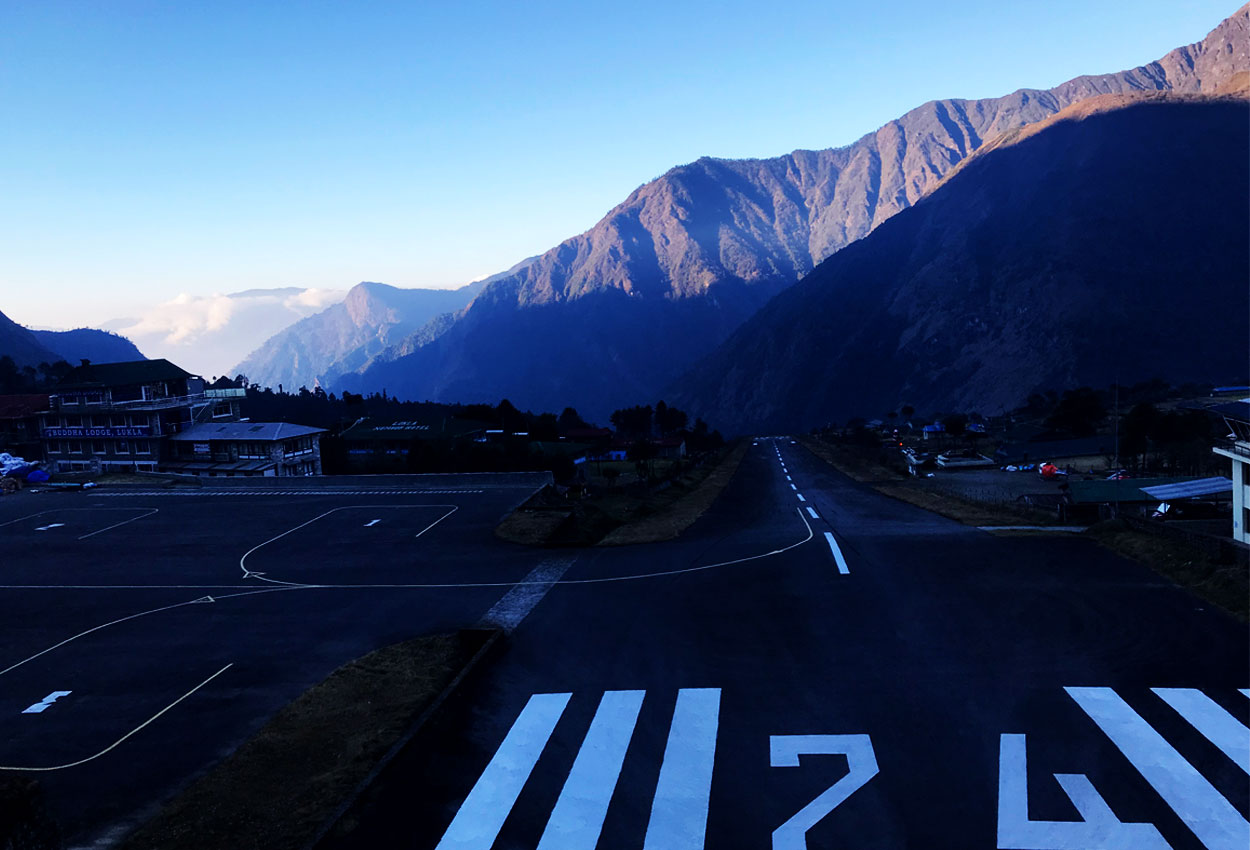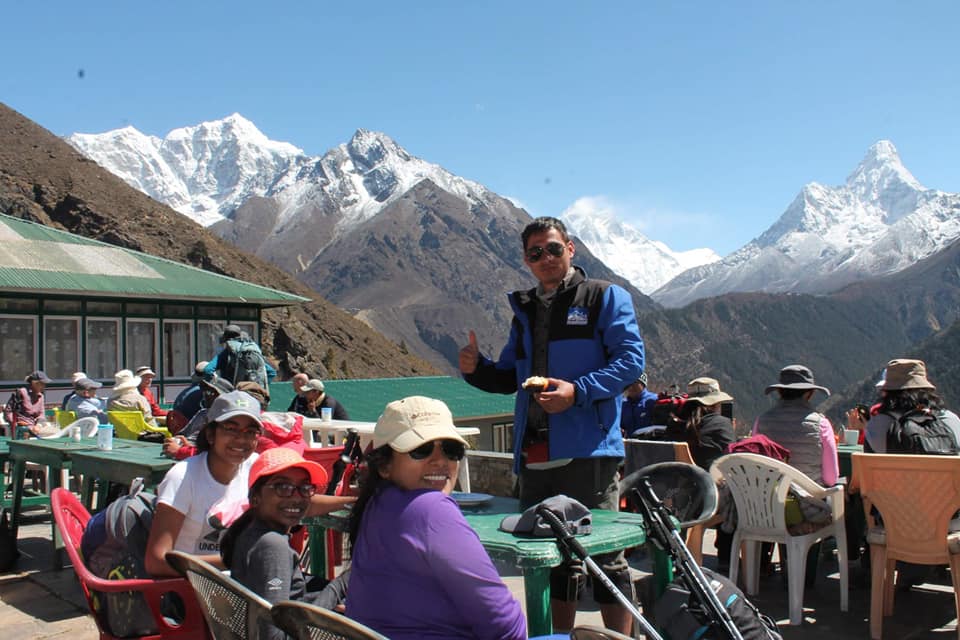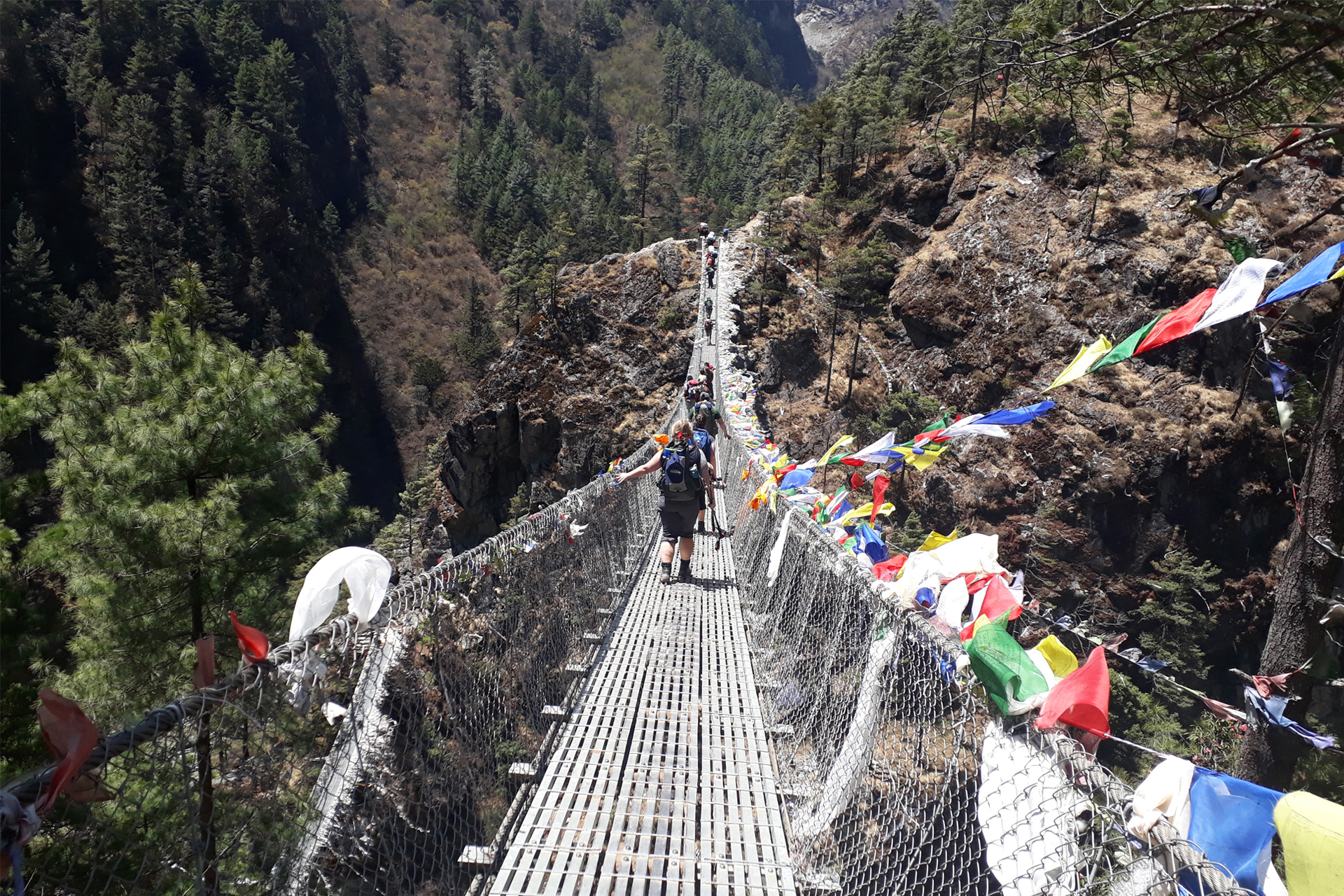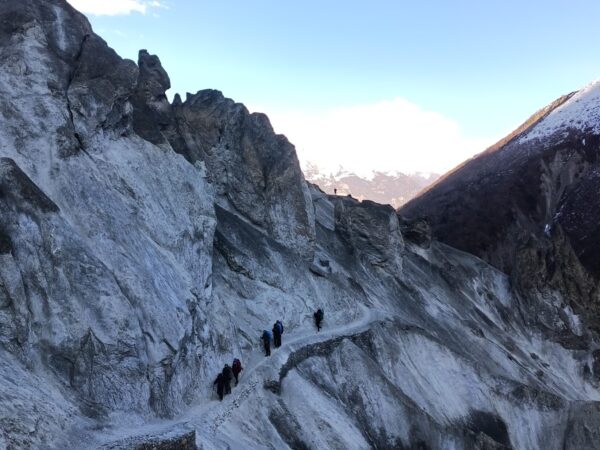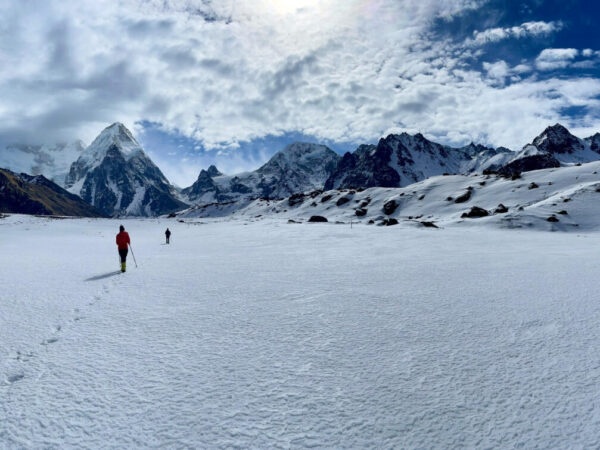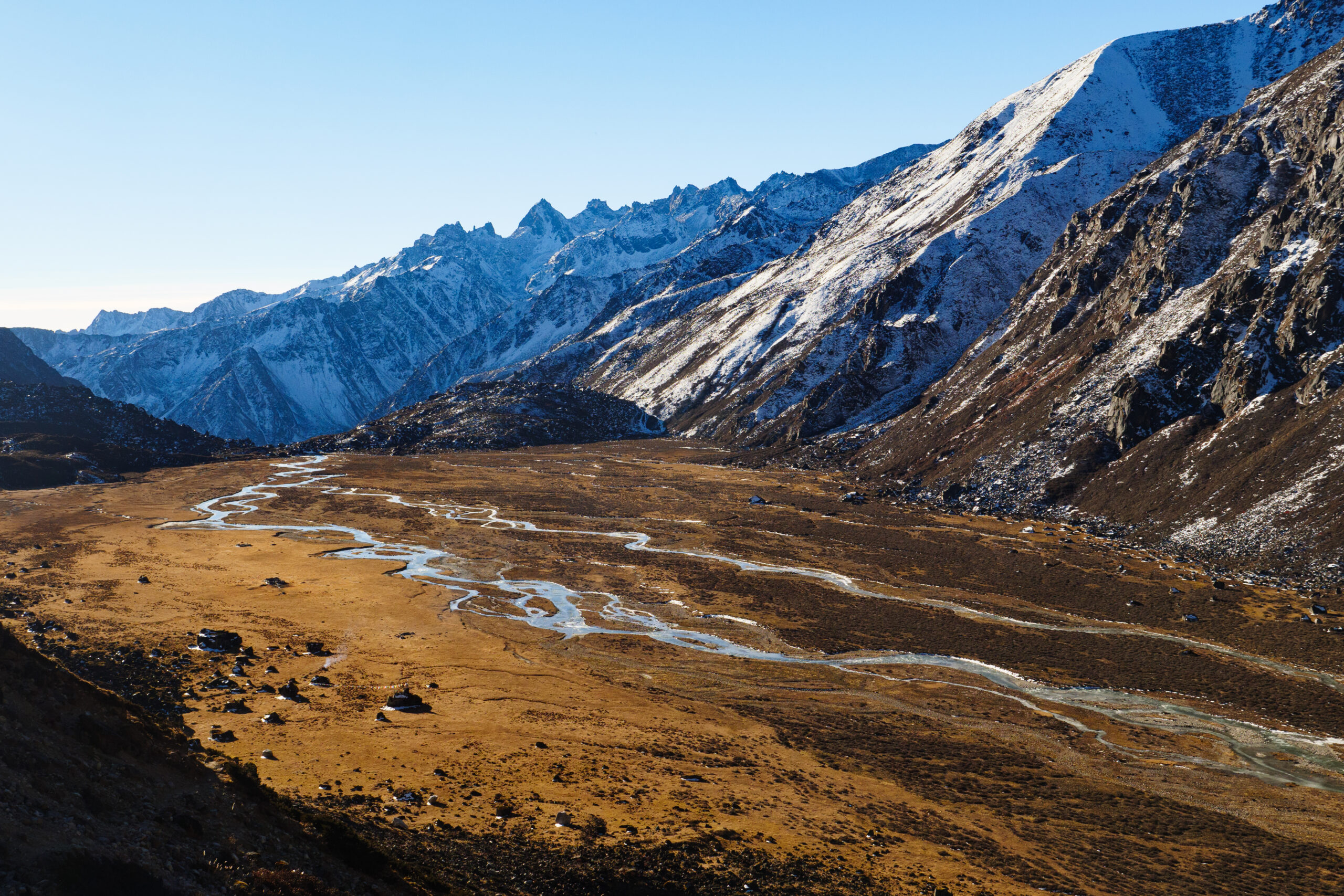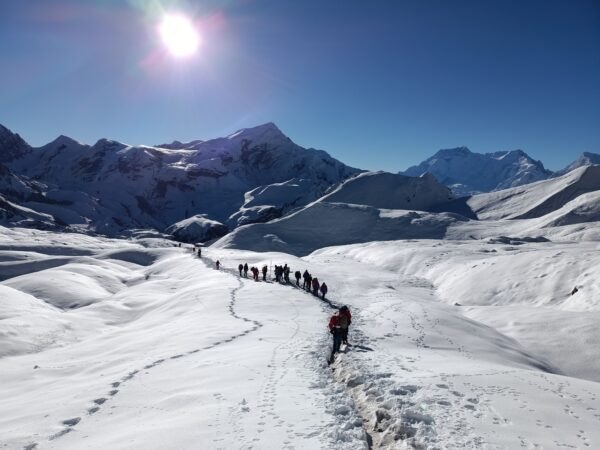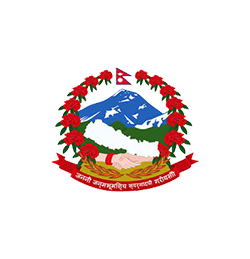Highlights
- Scenic Flight to Lukla: Your adventure begins with a thrilling flight from Kathmandu to Lukla, a small mountain town with a challenging airstrip carved into the mountainside.
- Namche Bazaar: The bustling Sherpa capital of the Khumbu region, Namche Bazaar offers a vibrant atmosphere with colorful markets, bakeries, and stunning views of the surrounding peaks.
- Sagarmatha National Park: Trekking through the UNESCO-listed Sagarmatha National Park, you'll encounter diverse flora and fauna, including rhododendron forests, Himalayan wildlife like musk deer and snow leopards, and rare bird species.
- Tengboche Monastery: Situated amidst awe-inspiring mountain scenery, Tengboche Monastery is one of the most significant Tibetan Buddhist monasteries in the Everest region, offering spiritual solace and breathtaking views of Everest and its neighboring peaks.
- Dingboche: Nestled in a picturesque valley, Dingboche provides stunning views of Ama Dablam and neighboring peaks. It's a great place for acclimatization and offers opportunities for short hikes to nearby viewpoints.
- Lobuche: As you ascend higher into the Khumbu Valley, you'll reach Lobuche, a remote outpost with incredible panoramic views of Everest, Lhotse, Nuptse, and the Khumbu Glacier.
- Gorak Shep: The last settlement before Everest Base Camp, Gorak Shep sits at the base of Kala Patthar and offers stunning sunset views over Everest and the Khumbu Icefall.
- Everest Base Camp: The ultimate destination of your trek, Everest Base Camp offers a surreal experience as you stand beneath the towering presence of Mount Everest, the world's highest peak.
- Kala Patthar: A viewpoint renowned for its breathtaking sunrise views of Everest, Kala Patthar offers an unparalleled panorama of the Himalayas, including Everest, Lhotse, Nuptse, and Changtse.
- Sherpa Culture and Hospitality: Throughout your trek, you'll have the opportunity to immerse yourself in Sherpa culture, interacting with local villagers, visiting ancient monasteries, and experiencing the legendary hospitality of the Sherpa people.
Overview
Everest Base Camp Trek has been a goal of thousands of novice, independent and anxious trekkers all around the world. Here you can get the genuine and honest facts of this trek before you come to achieve it. So, feel easy to ask if you have any queries regarding this trek.
Here, you’ll get general ideas of the overview of Everest Base Camp Trek along with itinerary, health requirements, packing list, permits, and frequently asked questions. Indeed, this article is especially for backpackers who want to trek to Everest Base Camp on their own path and also you can choose our offer if you would like to join us to achieve this lifetime journey to the Mt Everest Base Camp.
Everest Base Camps
Basically, Mt Everest has two base camps – one is on the Nepal side and another is on Tibet, China side. But Everest Base Camp Trek is a wonderful trip that begins from Lukla to approach Mt. Everest closer to reaching Everest Base Camp (5364 m) and Kala Pathar (5545 m). It literally means the trek lies in Nepal and reaches to South Base Camp of Mt Everest. This iconic journey leads you through a few Sherpa villages in Khumbu, offering the beauty of the Sagarmatha National Park. Meanwhile, you will be delighted with a mesmerizing view of the dignified mountains above 8000 m. Mt Lhotse, Mt Nuptse, Mt Cho Oyu, Mt Makalu, and Mt Ama Dablam are the major peaks that you can observe on this trek. You can also observe the customs and traditions of Local Sherpa people along with their lifestyle.
The trek covers a distance of 130 Kilometers beginning and ending in Lukla. To find out more, you can visit our article Everest Base Camp Trek Distance.
To reach Kalapathar is this trek’s ultimate destination, which is elevated 5545 m above sea level. Therefore, Everest Base Camp Trek is also known as Everest Kalapathar Trek.
The Everest Base Camp Trek begins from Kathmandu, however, the trek starts from Lukla. Alternatively, one can choose Jiri to EBC route to avoid the Lukla flight. But it requires 4-5 more days than Lukla to EBC route.
If you don’t wish to do such a long exhausting journey but want to see Mt Everest from closer, then Everest Base Camp Helicopter Tour can be another best alternative way to see Mt Everest for you. Check out 5 different trekking itineraries for Everest Base Camp
Everest Base Camp Trek Facts
- Altitude: Everest Base Camp sits at an altitude of 5,364 meters (17,598 feet) above sea level, making it one of the highest trekking destinations in the world.
- Distance: The trek to Everest Base Camp typically covers a distance of around 130 kilometers (80 miles) round trip, starting and ending in Lukla.
- Duration: The trek usually takes about 12-14 days to complete, allowing for proper acclimatization to the high altitude.
- Sagarmatha National Park: The trek passes through Sagarmatha National Park, a UNESCO World Heritage Site renowned for its unique biodiversity and stunning mountain landscapes.
- Tenzing Norgay and Edmund Hillary: In 1953, Tenzing Norgay and Sir Edmund Hillary became the first climbers to reach the summit of Mount Everest via the Southeast Ridge route, which starts from Everest Base Camp.
- Sherpa Culture: The trekking route is dotted with Sherpa villages, where you can experience the rich culture and traditions of the Sherpa people, renowned for their mountaineering prowess and hospitality.
- Kala Patthar: Kala Patthar, a prominent viewpoint near Gorak Shep, offers breathtaking panoramic views of Mount Everest, Lhotse, Nuptse, and surrounding peaks. It is a popular spot for watching the sunrise over Everest.
- Weather: Weather conditions in the Everest region can be highly variable and unpredictable, with temperatures ranging from mild to extremely cold, especially at higher elevations. It’s essential to be prepared for a wide range of weather conditions.
- Acute Mountain Sickness (AMS): Due to the high altitude, trekkers are at risk of experiencing symptoms of AMS, such as headache, nausea, and fatigue. Proper acclimatization, hydration, and gradual ascent are crucial for minimizing the risk of AMS.
- Environmental Concerns: The increasing number of trekkers and climbers in the Everest region has raised concerns about environmental degradation and waste management. Responsible trekking practices, including proper waste disposal and eco-friendly trekking practices, are essential for preserving the fragile Himalayan ecosystem.
- Trek Difficulty: Moderate
- Accommodation: Teahouse
- Guide and Porter: Both are not mandatory. You can go independently or can hire a guide and porter to support you and make your trip easy and joyful
- Required permits: Local government tax and Sagarmatha National Park Permit
- Best Time to Trek to EBC: March to May(Spring) and September to November(Autumn)
- Start and End Point: Kathmandu to Kathmandu
Transportation for Everest Base Camp Trek
Generally, you will take either taxi or a private vehicle to go to Tribhuvan International Airport as it is the only airport that conducts a Lukla flight. However, the roads of Kathmandu are very congested, so as you can say it is badly regulated and has the poor condition of transportation. In case you choose to trek Everest Base Camp via Jiri Route, then you need a standard vehicle and driver for all your transfers. In the monsoon season, the hilly roads of Nepal are prone to landslides and accidents.
Food on Everest Base Camp Trek
Unlike the luxury hotel in a city like Kathmandu, you will not get a wide variety of meal menus during the Everest Base Camp Trek.
You get to have a few options of food while Dal Bhat Tarakari will be the favorite of many people as it is also a common and national meal in Nepal. Dal Bhat is provided by a teahouse that also serves as accommodation for trekkers. Basically, they provide a twin-shared room with separate beds. Likewise, some lodge base teahouses do also provide hot showers, and can also serve laundry service charging a small fee.
During the Everest Base Camp trek, you’ll find a variety of foods available at the tea houses and lodges along the trail. Here are some common foods you can expect to encounter:
- Dal Bhat: A traditional Nepali meal consisting of rice (bhat), lentil soup (dal), vegetables, pickles, and sometimes meat or fish. It’s a staple food for trekkers due to its high carbohydrate and protein content.
- Momos: These are Tibetan-style dumplings filled with meat or vegetables and served with a spicy dipping sauce. They’re a popular snack or appetizer along the trekking route.
- Sherpa Stew: A hearty stew made with potatoes, vegetables, and sometimes meat, simmered in a flavorful broth. It’s a warming and nourishing dish, perfect for replenishing energy after a long day of trekking.
- Noodles: Whether in soup or stir-fried, noodles are a quick and comforting option available at most tea houses along the trail. You can choose from a variety of toppings, including vegetables, eggs, and meat.
- Fried Rice: Another popular dish, fried rice is made with rice, vegetables, eggs, and sometimes meat, stir-fried together with aromatic spices. It’s a filling and satisfying meal for trekkers.
- Pizza: Surprisingly, many tea houses along the Everest Base Camp trek offer pizza on their menus. While it may not be traditional Nepali fare, it’s a familiar comfort food for many trekkers.
- Pancakes and Chapatis: For breakfast or a snack, you’ll often find pancakes (with toppings like honey or jam) and chapatis (flatbreads) served with butter or jam. They provide a quick burst of energy to start your day or refuel along the trail.
- Porridge: A warm and nourishing option for breakfast, porridge (made from oats or other grains) is often served with milk, honey, and dried fruits. It’s a comforting choice, especially on chilly mornings.
- Tea and Hot Beverages: Tea is a vital part of Nepali culture, and you’ll find a variety of teas available along the trekking route, including masala chai, ginger tea, and herbal teas. Hot chocolate, coffee, and other hot beverages are also available to warm you up after a long day of trekking.
- Snacks: Along with meals, you’ll find a variety of snacks available at tea houses, including energy bars, chocolate, nuts, and biscuits. These are convenient for munching on during breaks or to carry as snacks for the trail.
Available Accommodation in Everest Base Camp Trek
Accommodation along the Everest Base Camp trek primarily consists of tea houses, also known as guesthouses or lodges. These are basic but comfortable accommodations located in villages and settlements along the trekking route. Here’s what you can expect from tea house accommodation during your Everest Base Camp trek:
- Basic Rooms: Tea houses offer simple rooms with twin beds or bunk beds, basic bedding (usually blankets), and sometimes a small table or shelf. Rooms may be private or shared, depending on availability and your preference.
- Common Areas: Most tea houses have communal areas where trekkers can relax, socialize, and enjoy meals. These areas often feature benches, tables, and sometimes a fireplace or stove to provide warmth.
- Shared Bathrooms: Bathroom facilities in tea houses are usually shared and may consist of squat toilets or Western-style toilets. Hot showers are often available for an additional fee, although water availability and temperature may vary.
- Dining Hall: Tea houses typically have a dining hall or communal area where meals are served. This is where trekkers gather for breakfast, lunch, and dinner, enjoying hearty meals and swapping stories of their trekking adventures.
- Menu Options: Tea houses offer a menu with a variety of food and beverage options, including traditional Nepali dishes (such as dal bhat), Tibetan specialties (like momos), as well as Western comfort foods (such as pasta and pizza). Vegetarian and vegan options are usually available, and some tea houses can accommodate dietary restrictions with advance notice.
- Electricity and Charging: While electricity is available in many tea houses, it may be limited or available only during certain hours. Charging electronic devices such as cameras and phones is usually possible, although some tea houses may charge a small fee for this service.
- Altitude Considerations: As you ascend higher into the mountains, accommodation options may become more basic, with fewer amenities and shared facilities. It’s essential to be prepared for colder temperatures and thinner air at higher elevations.
- Booking in Advance: During the peak trekking seasons (spring and autumn), it’s advisable to book accommodation in advance, especially in popular trekking villages like Namche Bazaar and Gorak Shep. However, during the off-peak seasons, you may have more flexibility in finding accommodation on the spot.
What Kind of Food and Drinking Water Can You Expect by Everest Hikes?
One of the best parts of Everest Base Camp Trek is the chance to enjoy warm, hearty meals in cozy tea houses along the trail. Most days start and end with breakfast and dinner at the tea house where you’re staying, while lunch is usually at a trail-side restaurant, giving you a well-earned break from hiking.
You’ll always find the classic Nepali Dal Bhat—a satisfying combo of rice, lentils, and seasonal veggies. But that’s not all. Tea house menus also offer plenty of variety, from noodles and soups to potatoes and rice dishes. If you’re craving a taste of home, many places serve Nepali-style versions of Western comfort foods like pizza, pasta, and even French fries.
To wash it all down, you can grab a soft drink, snack, or even a cold beer. And no trek in Nepal is complete without countless cups of Nepali milk tea, served pretty much everywhere you go.
Staying Hydrated the Eco-Friendly Way
Every tea house provides boiled water, so you can refill your bottles and stay hydrated without worry. We always recommend skipping bottled water—plastic waste is tough to manage in the mountains and can harm the environment.
Bringing a reusable bottle with a filter or using boiled water not only keeps you safe but also helps protect the beautiful trails and villages that make the Everest region so special.
What type of hotel can we find in Kathmandu city?
There is a wide variety of hotels ranging from 2 star – to 5-star in Kathmandu valley. Even you can get a very normal hotel around Thamel – a tourist center of Kathmandu.
Is it possible to book a tea house room by yourself?
It is a little bit hard to book a teahouse room in advance by an independent trekker. There are a few reasons behind these conditions:
- Trekkers might not have enough contact information about the teahouses
- If trekkers try booking the room by contacting teahouses, there is no guarantee of room booking. Because it is a remote area where almost all of the teahouses do not have an online booking system. So, they can’t be sure whether it is an original or fake booking.
Trekking companies and guides, on the other hand, have stronger and more established relationships with teahouses, allowing them to secure better accommodations along the Everest Base Camp Trek. This means we can offer superior connections and ensure a more seamless experience with the teahouses and lodges along the trail.
Note: You can’t expect high facilities in the tea house.
Laundry Services on Everest Hikes
While trekking in the Everest region, staying fresh can be a challenge, but there are options to keep your clothes clean. Some of the hotels and lodges along the trail offer laundry services for an additional charge.
However, there might be times when you’ll need to wash a few items yourself. We recommend bringing non-polluting, biodegradable soap to minimize your environmental impact while enjoying the stunning landscapes of the Himalayas.
Staying clean on the trail not only feels great but also helps you enjoy the journey more comfortably!
Everest Base Camp Trek difficulty and health requirements
It is considered to be a moderate trek although it accesses Kalapathar which is 5545 m above sea level. Nevertheless, you should not take it so easily as many people have got altitude sickness while trekking in Everest.
To overcome the chances of altitude sickness, you need to do some physical activities at least 10-15 days prior to the trek. It would have been far better if you have already hiked some mountains. It may be applicable for those people who have been living just close to the height of sea level.
Basically, you need to be physically and mentally fit to trekking to Everest Base Camp. It does not require any mountaineering skills as it only passes through terrain land and hikes to the steep hill.
Kathmandu to Lukla Flight Cancellation
Since the classic Everest Base Camp Trek begins from Lukla, we need to take a short flight to Lukla from Kathmandu. It only takes 40 minutes approx to arrive at Lukla from Kathmandu. Nevertheless, no one can be 100% sure about the weather in the Himalayas. It might be changed anytime. Consequently, the Lukla flight may be canceled or can not be landed on Lukla.
Therefore, I would like to suggest everyone add 1 or 2 spare days in order to ensure your trekking on Everest. Alternatively, there is the possibility of helicopter service in a group joining spending some money. The helicopter service charges may range from $300 to $500 for each of the members. In a helicopter, there will be a maximum of 5 members at a time.
Everest Base Camp Trek Permits
The basic required permits for Everest Base Camp Trek are listed below:
- Khumbu Pasang Lhamu Rural Municipality Entrance Fee
- Sagarmatha National Park Entry Fee
- TIMS (Trekking Information Management System) fee
The first two permits are now the must-require permits. However, about the third permit – TIMS, there are a lot of controversies still going on. But you are allowed to trek EBC just having Khumbu Pasang Lhamu Rural Municipality Entrance and Sagarmatha National Park Entry permits.
Khumbu Pasang Lhamu Rural Municipality Entrance Fee
You can’t get this permit in Kathmandu. It is like a replacement of a TIMS permit which is directly collected by Khumbu Pasang Lhamu Rural Municipality. It can be obtained either in Lukla or in Monjo Village.
Cost: Rs 2000 per person
Sagarmatha National Park Entry Fee
It is another must-required permit that can be obtained in Kathmandu at Nepal Tourism Board or in Monjo village just prior to entering the National Park.
Cost: Rs 3000 per person
Note: If you are planning to do the Everest Base Camp Trek from Jiri, then you need an additional permit i.e Gaurishankar Conservation Area Permit. Because you will be passing through Gaurishankar Conservation Area which also costs Rs. 3000 and it also can be obtained in Kathmandu.
What documents are required to issue Everest Base Camp Trek permits?
It is enough to have valid passport details to issue the permits to trek to Everest. But all permits are only for a single entry and once the permits are issued, they can not be refunded.
Outline Itinerary
Day 01: Arrival in Kathmandu (1,400m / 4,593ft) and transfer to Hotel
Day 02: Fly to Lukla (2,880m / 9,448ft), then trek to Phakding (2,610m / 8,563ft) – 3 to 4 hours
Day 03: Trek to Namche Bazaar (3,440m / 11,286ft) – 6 to 7 hours
Day 04: Acclimatization day in Namche Bazaar (3,440m / 11,286ft) – Optional short hike to Everest View Hotel (3,880m / 12,729ft)
Day 05: Trek to Tengboche (3,860m / 12,664ft) – 5 to 6 hours
Day 06: Trek to Dingboche (4,410m / 14,468ft) – 5 to 6 hours
Day 07: Acclimatization in Dingboche (4,410m / 14,468ft) – Optional hike to Nagarjun Hill (5,050m / 16,568ft)
Day 08: Trek to Lobuche (4,940m / 16,207ft) – 5 to 6 hours
Day 09: Trek to Everest Base Camp (5,364m / 17,598ft) and return to Gorak Shep (5,164m / 16,942ft) – 7 to 8 hours
Day 10: Hike to Kala Patthar (5,545m / 18,192ft) and trek back to Pheriche (4,280m / 14,041ft) – 7 to 8 hours
Day 11: Trek back to Namche Bazaar (3,440m / 11,286ft) – 6 to 7 hours
Day 12: Trek back to Lukla (2,880m / 9,448ft) – 6 to 7 hours
Day 13: Fly back to Kathmandu (1,400m / 4,593ft)
Day 14: Rest day / Shopping day / Sightseeing
Day 15: Final Departure
Is this trek suitable for me?
Weather and Travel Disruptions in the Himalayas
Weather in the Himalayas can be unpredictable, and it’s important to prepare for potential delays or cancellations, especially concerning flights to or from Lukla. Every year, numerous trekkers experience disruptions due to weather conditions. If your flight is affected, we have alternative plans outlined in the itinerary for day 1 to ensure a smooth continuation of your journey.
Trekking in the Himalayas: A Challenge Worth Taking
Trekking in the Everest region is an incredible, but challenging experience. The trek spans 12 days, with daily hikes of up to eight hours, reaching altitudes over 5,500 meters. The weather can be harsh, particularly depending on the season, so being in top physical condition is crucial for your safety and enjoyment. Only those in excellent health should consider joining this adventure. For tips on how to prepare physically for this trek, check out our comprehensive training guide.
Teahouses and Basic Amenities
Along the Everest Base Camp trek, accommodation is provided in simple teahouses. While these lodges offer basic facilities, they provide a great opportunity to interact with fellow trekkers and locals. Note that charging your devices may incur additional costs, and Wi-Fi, though available at some teahouses, may have limited connectivity.
Season and Packing Considerations
The weather and trekking conditions vary with the seasons. It’s essential to carefully consider the best time to trek and prepare accordingly. For a detailed packing guide, we recommend reviewing our recommendations to ensure you have everything needed for your Everest adventure.
A Popular Trek with Fellow Adventurers
As one of the most popular trekking routes in Nepal, the Everest Base Camp trail is frequently traveled by many adventurers. You will likely meet other trekkers along the way and at the teahouses. If you prefer a less crowded experience and want to explore more remote villages, consider our Tamang Heritage & Langtang Valley Trek for a more secluded adventure.
High Altitude and Acute Mountain Sickness (AMS)
This trek includes multiple overnight stays at altitudes over 3,500 meters (11,500 feet), where there is a risk of Acute Mountain Sickness (AMS). While most trekkers experience only mild discomfort, it’s essential to be aware of AMS symptoms and treatment options. If left untreated, AMS can be life-threatening. Our experienced guides and local staff will ensure that any trekkers showing symptoms receive the necessary care.
Pre-existing medical conditions and medications can impact your body’s ability to acclimatize to high altitudes, making you more susceptible to AMS. If you have concerns about your health or physical fitness, it’s advisable to consult a doctor before booking your trek. You may also want to discuss using medications like Diamox to aid acclimatization
Everest Base Camp Trek – 15 Days - Itinerary
Arrival in Kathmandu (1,400m / 4,593ft) and transfer to Hotel
One of the representives of Everest Hikes will be there to pick you up and transfer to the hotel.
Fly to Lukla (2,880m / 9,448ft), then trek to Phakding (2,610m / 8,563ft) – 3 to 4 hours
Flying in a short scary domestic flight to Lukla and following the bank of Dhudhkoshi River crossing a few quizzical suspension bridges, you arrive at a small Sherpa Village called Phakding by 2-3 hours walk. Here it will be your first mountain overnight.
Either your tour operator will arrange the flight ticket for you or you should purchase the tickets at the airport. However, the ticket can be unavailable during peak trekking and climbing seasons. So, it would be better to buy tickets earlier either through a travel agency or directly from the airline's website. Basically, the Lukla flight ticket costs around 280 USD which includes a return ticket as well.
Flying in a short scary domestic flight to Lukla and following the bank of Dhudhkoshi River crossing a few quizzical suspension bridges, you arrive at a small Sherpa Village called Phakding by 2-3 hours walk. Here it will be your first mountain overnight.
Either your tour operator will arrange the flight ticket for you or you should purchase the tickets at the airport. However, the ticket can be unavailable during peak trekking and climbing seasons. So, it would be better to buy tickets earlier either through a travel agency or directly from the airline's website. Basically, the Lukla flight ticket costs around 280 USD which includes a return ticket as well.
There are chances of cancellation of Lukla's flight due to bad weather. So, we recommend you make a flexible itinerary as much as it is possible. Having one or two spare days would be better.
Trek to Namche Bazaar (3,440m / 11,286ft) – 6 to 7 hours
Today, you will be trekking through some local villages like Monjo, Jorsalle, etc till reaching Namche Bazaar - The biggest Sherpa town in the region. You can cut your lunchtime in Monjo as many trekkers do. From here, you will be entering Sagarmatha National Park which is home to many endangered wild animals. It has been also enlisted in UNESCO WORLD Heritage Site.
You will take a steep hike to Namche Bazaar after passing Jorsalle. It will take you 2 hours approx to reach Namche Bazaar. You will have enough time to visit Namche Bazaar and see the small markets.
From Namche Bazaar, the Everest Three High Passes Trekking route separates and moves toward Thame vilage which follows the path to Renjo La Pass, while the EBC route goes to Tengboche.
Acclimatization day in Namche Bazaar (3,440m / 11,286ft) – Optional short hike to Everest View Hotel (3,880m / 12,729ft)
Reaching 3440 m altitude above sea level, anyone could suffer from altitude sickness problems. So, Namche is a great stop for acclimatization for Everest Trekkers. It will offer an opportunity to explore the village from near.
In addition, many love to hike to Everest View Hotel to see a glimpse of Mt Everest and the surrounding mountains. You can chill here by having a cup of tea or coffee; you also can snap awe-inspiring pictures of Mt Ama Dablam in the foreground while Mt Everest will be in the background if the sky is crystal clear. Besides that, the hotel provides WiFi that enables you to contact your relatives and share how you are feeling.
Trek to Tengboche (3,860m / 12,664ft) – 5 to 6 hours
Today, you will be heading toward Tengboche, the home of one of the largest monasteries in Khumbu i.e Thyangboche Monastery. It is a mixture of great architecture and color that has a history of over 500 years.
Trek to Dingboche (4,410m / 14,468ft) – 5 to 6 hours
On the 6th day, either you will head to Dingboche or Pheriche. The way follows the same path until it reaches Worshyo Village. It then separates - one way goes to Pheriche and another to Dingboche. I always advise choosing Dingboche when you are going toward EBC. If you are coming down, then staying in Pheruche would be good. From Dingboche, Ama Dablam mountain is very closer. A way goes toward Chhukung from Dingboche that traces a path to Island Peak Climbing. However, the next day, we will not take our path to Chhukung because the EBC trek moves toward Lobuche.
In fact, the EBC route from Dingboche or Pheriche, both meet at the same point i.e Dughla, then approach the Lobuche where you will spend your 7th overnight stay at the mountain.
Acclimatization in Dingboche (4,410m / 14,468ft) – Optional hike to Nagarjun Hill (5,050m / 16,568ft)
It’s a good idea to spend an extra day acclimatizing before venturing into higher altitudes, and a great way to do this is by hiking to Chukkung Valley (4,730m) and continuing to Island Peak (Imja Tse). From Dingboche, you can take a challenging 2- to 3-hour trek up to Nagkartshang Gompa, or if you prefer, you could head to Pheriche for an informative afternoon lecture on altitude sickness.
The trail to Chhukung leaves Dingboche and winds toward Bibr (4,570m), offering spectacular views of towering peaks like Taboche, Nuptse, Lhotse, and Ama Dablam, as well as the dramatic, flute-shaped Amphu Laptsa Pass. Chukkung itself is a popular base for climbers heading to Island Peak, with several lodges offering a cozy stopover.
If you're feeling well acclimatized, you can push on to Chukkung Ri (5,550m), a grassy slope that rewards hikers with breathtaking panoramic views, including a stunning vista of Makalu. Breakfast, lunch, and dinner are all included for the day.
Trek to Lobuche (4,940m / 16,207ft) – 5 to 6 hours
As I already mentioned that your path from Pheriche or Dingboche meets at Dughla village, and head toward Lobuche having extraordinary scenery of mountains. Within 5-6 hours, you will be at Lobuche village.
Trek to Everest Base Camp (5,364m / 17,598ft) and return to Gorak Shep (5,164m / 16,942ft) – 7 to 8 hours
From Lobuche, you walk through a rough rocky terrain path passing Gorakshep. You will spend 40 minutes approx in EBC enjoying and collecting the view of Nuptse, Lhotse, Pumori, etc mountains. Thereafter you come back to Gorakshep for an overnight stay.
Hike to Kala Patthar (5,545m / 18,192ft) and trek back to Pheriche (4,280m / 14,041ft) – 7 to 8 hours
Approximately 2 hours hike to Kalapathar will wonder you today when you reach there. Kalapathar is the optimal viewpoint of Mt Everest and its neighboring mountains. After spending 30 minutes, you then will come down to Gorakshep and may have lunch before moving down to Pheriche.
Trek back to Namche Bazaar (3,440m / 11,286ft) – 6 to 7 hours
When you will be coming down to Namche via Tengboche, keep your camera ready to capture beautiful photos of rhododendron forests.
Trek back to Lukla (2,880m / 9,448ft) – 6 to 7 hours
You will walk approximately 6 hours today to come back to Lukla. Then you may celebrate the night with your team as you succeed in the EBC trek.
Fly back to Kathmandu (1,400m / 4,593ft)
Take a short flight from Lukla to Kathmandu in the morning and the rest of the day will be on your hand. You can spend how you want to. You may visit around Thamel or may go for 1-day heritage sightseeing in Kathmandu valley.
Rest day / Shopping day / Sightseeing
After completing the EBC trek, enjoy a well-deserved rest day in Kathmandu. You can relax, explore vibrant local markets for shopping, or embark on a sightseeing tour to discover the city's cultural treasures.
Final Departure
Inclusions
What's included
- Airport transfers - pickup and drop off
- Boutique hotel accommodation in Kathmandu - 3 nights with breakfast included
- An Experience English speaking guide
- Porter - 1 porter for every 2 trekkers
- All Meals - breakfast, lunch, and dinner and Teahouse accommodation during the trek
- Kathmandu to Lukla Flight Ticket (Round Trip)
- All required trekking permits (National Park Entry Fee and Pasang Lhamu Rural Municipality Entry Fee)
- Guide insurance with food and accommodation
- Basic Medical kits
- Sleeping and duffel bag, down jacket, trekking poles (should be returned after the trek)
- Emergency Helicopter Evacuation Service Arrangement Only (should cover by your travel insurance)
- All required paper works and government taxes
- Farewell dinner
What's not included
- International Flight
- Nepal Travel Visa Fee
- Hotel in Kathmandu
- Personal Medical and Travel insurance (Should cover helicopter evacuation)
- Guide, Porter and Driver tips
- Personal Gears (equipment)
- Personal bill
- Lunch and Dinner in Kathmandu
- All other personal expense of beverages (hard and soft drinks)
- All other things not mentioned in the inclusion
Route Map
There are several maps you can get on premium online. Instead, you can buy it after you arrive in Kathmandu.
Altitude Chart
Equipment
Recommended Trekking Gears
Clothing
- Base Layers (Moisture-Wicking)
- Thermal tops and bottoms (polyester or merino wool)
- Lightweight long-sleeve shirts
- Insulating Layers
- Fleece jacket or pullover
- Down jacket (for high-altitude treks)
- Warm sweaters
- Outer Layers (Shells)
- Waterproof and windproof jacket (Gore-Tex or similar)
- Waterproof pants
- Trekking Pants
- Quick-dry pants
- Convertible hiking pants (zip-off into shorts)
- Trekking Shirts
- Lightweight and breathable T-shirts
- Long-sleeve shirts with UV protection
- Headwear
- Wide-brim hat or cap for sun protection
- Warm beanie for cold temperatures
- Buff or scarf for dust and wind
- Gloves
- Lightweight trekking gloves
- Insulated gloves for higher altitudes
- Socks
- Moisture-wicking trekking socks
- Thermal socks for colder regions
- Footwear
- Sturdy and waterproof trekking boots (well broken-in)
- Comfortable sandals or camp shoes (for evenings/rest days)
- Gaiters (optional, for snow or muddy trails)
Backpacks & Bags
- Backpack
- 40-50L capacity for multi-day treks
- Comfortable straps and rain cover
- Daypack
- 20-30L for short treks or carrying essentials during the day
- Duffel Bag
- Used if porters are carrying your gear (for organized treks)
- Dry Bags
- To keep electronics and clothes dry in wet conditions
Sleeping Gear
- Sleeping Bag
- 4-season sleeping bag (rated for -10°C to -20°C for high-altitude treks)
- Sleeping bag liner (optional, for extra warmth and hygiene)
- Sleeping Pad (if camping)
- Lightweight and inflatable or foam pads for comfort
Trekking Accessories
- Trekking Poles
- Adjustable and lightweight poles (essential for steep ascents/descents)
- Water Bottle/Hydration System
- Insulated bottle (to prevent freezing at high altitudes)
- CamelBak or similar hydration reservoir
- Water Purification
- Water filters, purification tablets, or UV sterilizers
- Sunglasses
- UV protection (Category 3 or 4 for snowy conditions)
- Headlamp
- With spare batteries (essential for early morning or late-night treks)
- Multi-tool or Knife
- For various small tasks
- First Aid Kit
- Bandages, blister patches, antiseptic wipes, painkillers, Diamox (for altitude sickness), etc.
- Lip Balm
- SPF-protected to prevent chapping
- Sunscreen
- High SPF for UV protection at higher altitudes
- Personal Toiletries
- Biodegradable soap, toothpaste, toothbrush, quick-dry towel, wet wipes, and toilet paper
Optional but Useful Items
- Camera
- To capture the stunning scenery (extra batteries and memory cards are a must)
- Snacks
- Energy bars, trail mix, or chocolate for quick energy boosts
- Power Bank/Solar Charger
- For charging devices in remote areas
- Books or E-Readers
- For downtime during rest days
- Earplugs
- To block out noise in lodges or camps
- Notebook/Journal
- To record your trek experience
Clothing Packing Tips
- Layering is key: It helps regulate your body temperature and adapt to changing weather.
- Avoid cotton: It retains moisture and dries slowly, which can lead to discomfort or hypothermia.
- Pack light: Only carry what is absolutely necessary to avoid unnecessary weight.
Gear Rentals in Nepal
If you're worried about carrying too much gear, trekking hubs like Kathmandu and Pokhara offer trekking equipment rentals and sales. You can find items like sleeping bags, down jackets, and trekking poles at reasonable prices. However, ensure you check the quality before renting.

